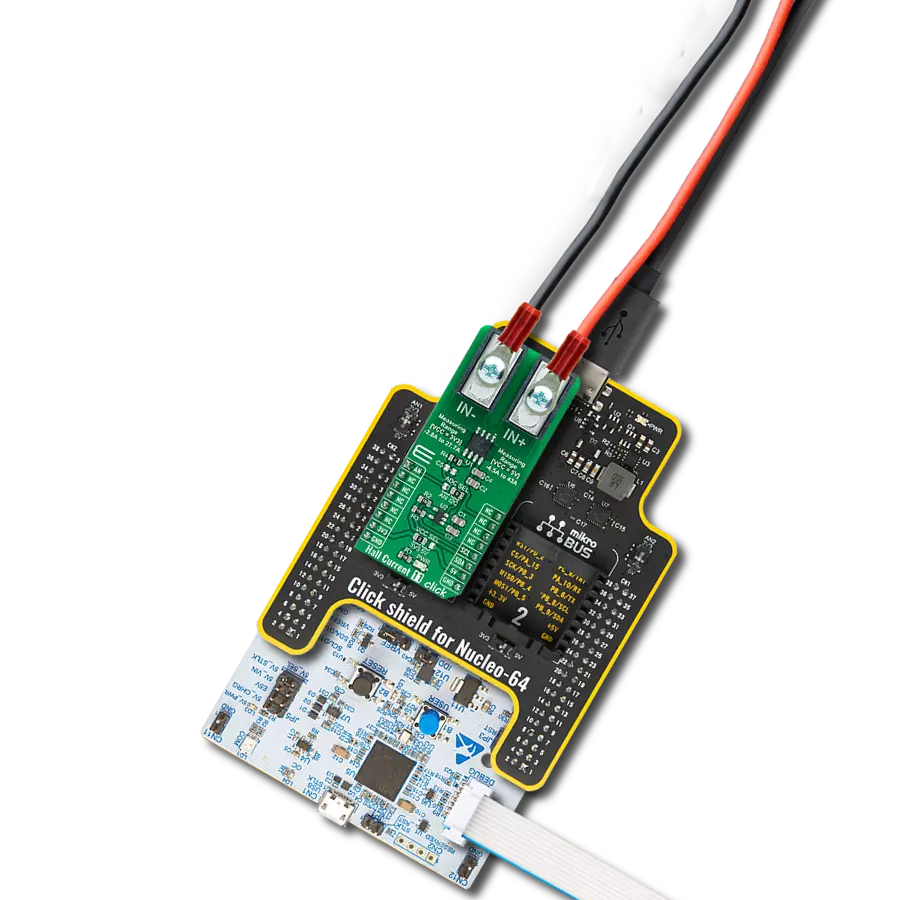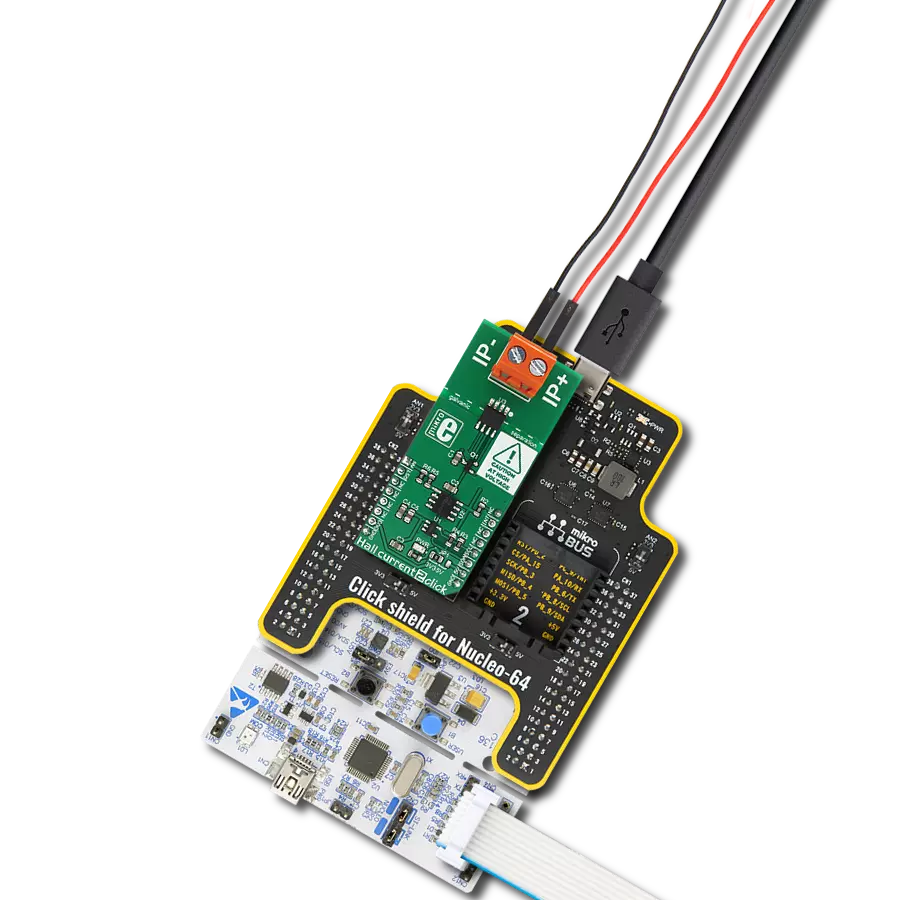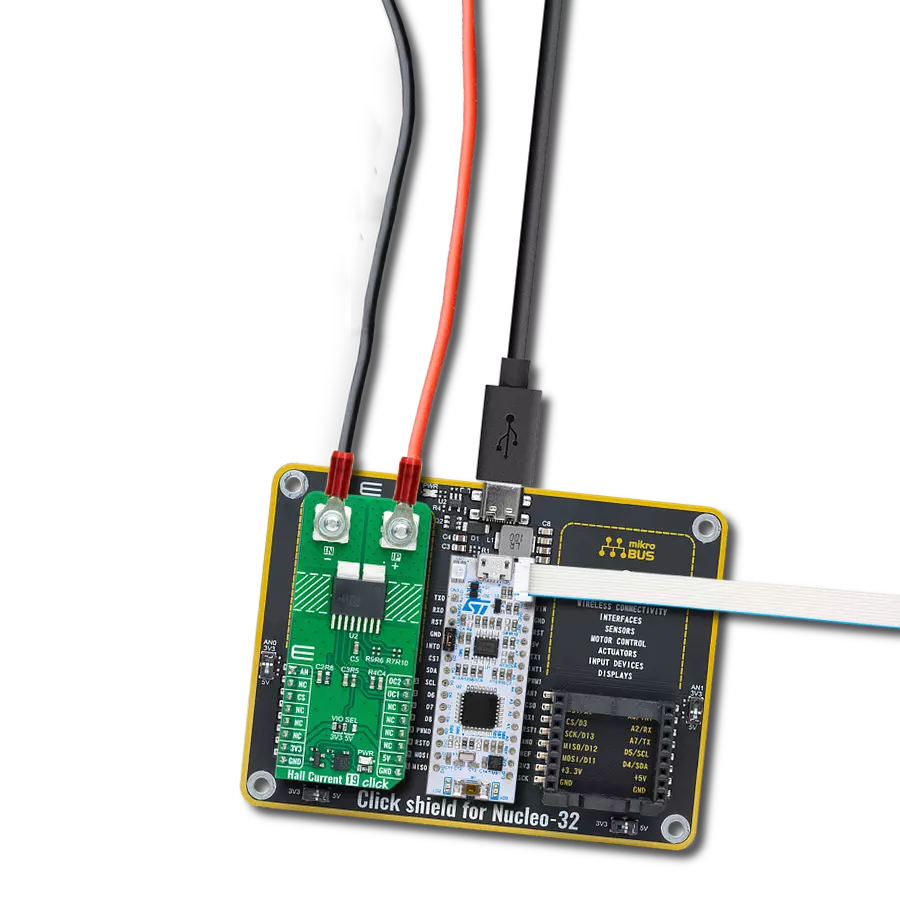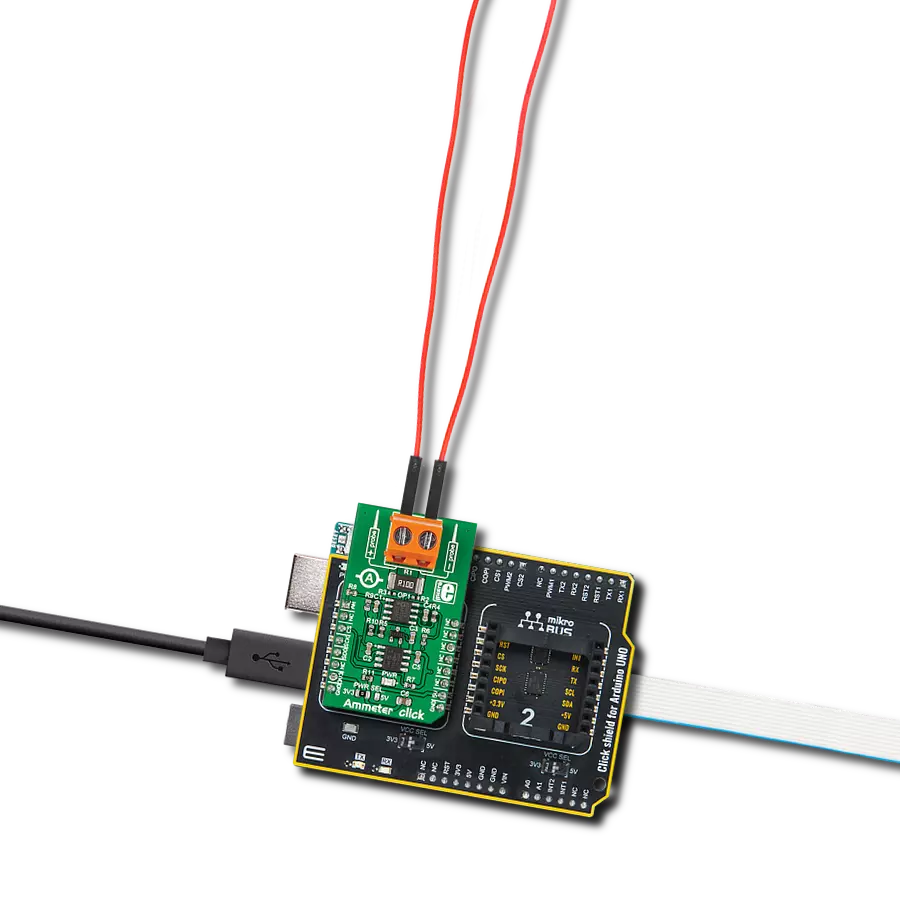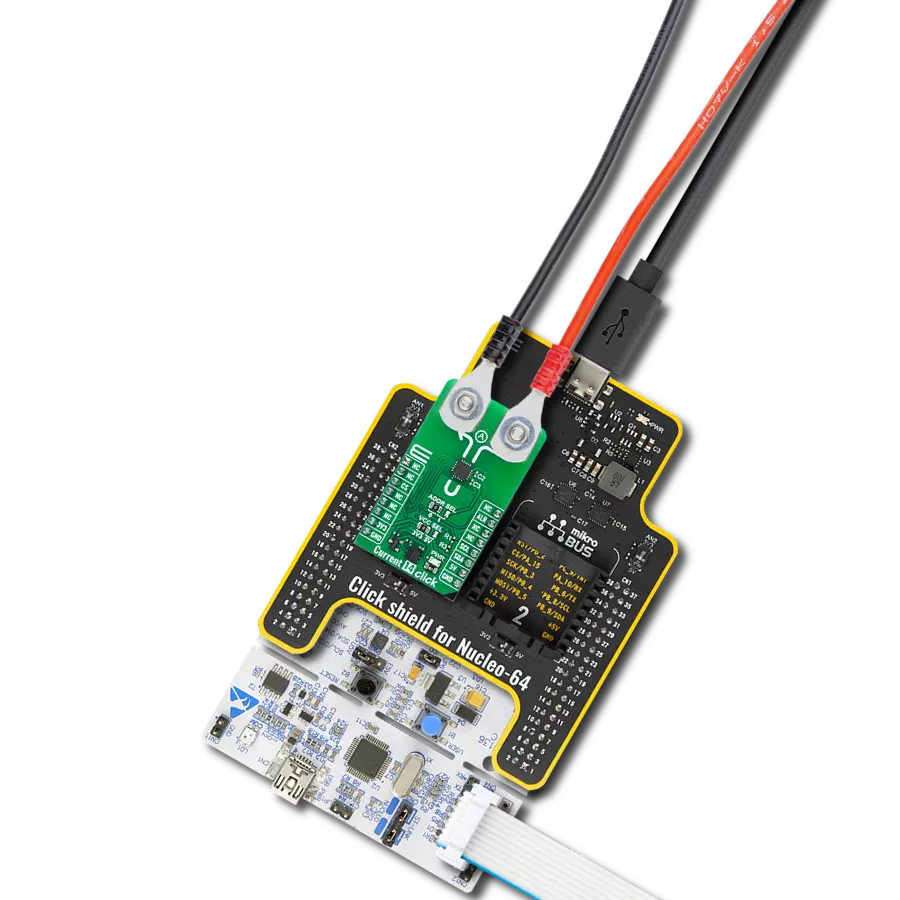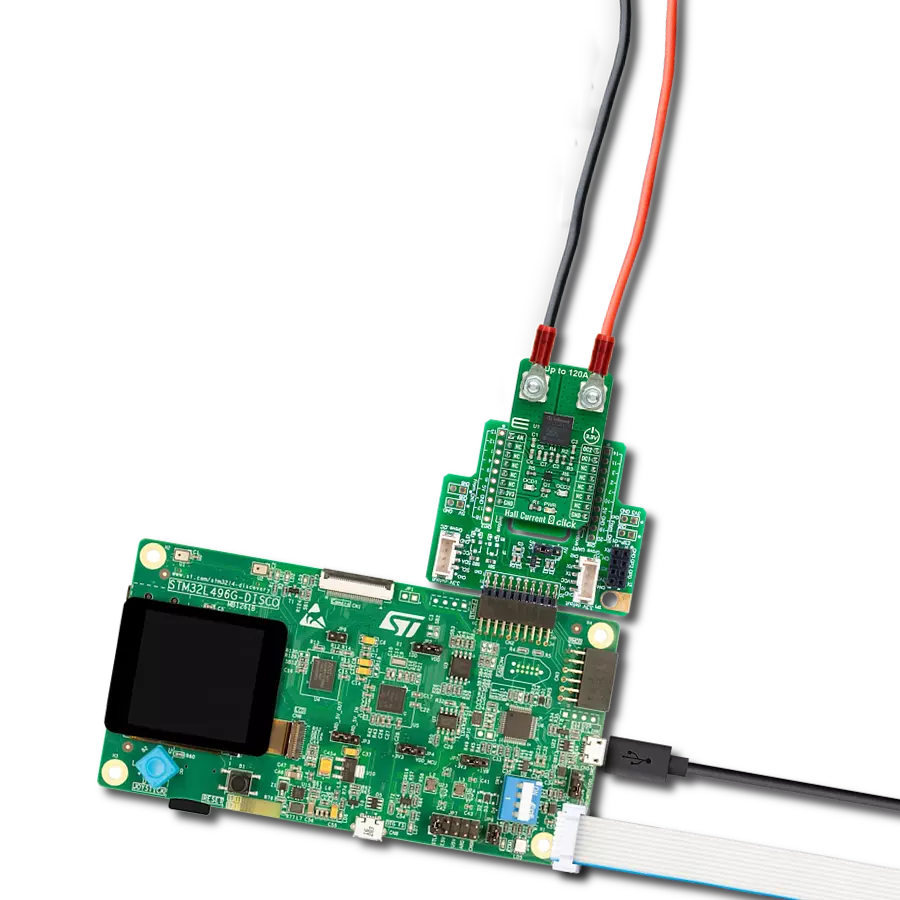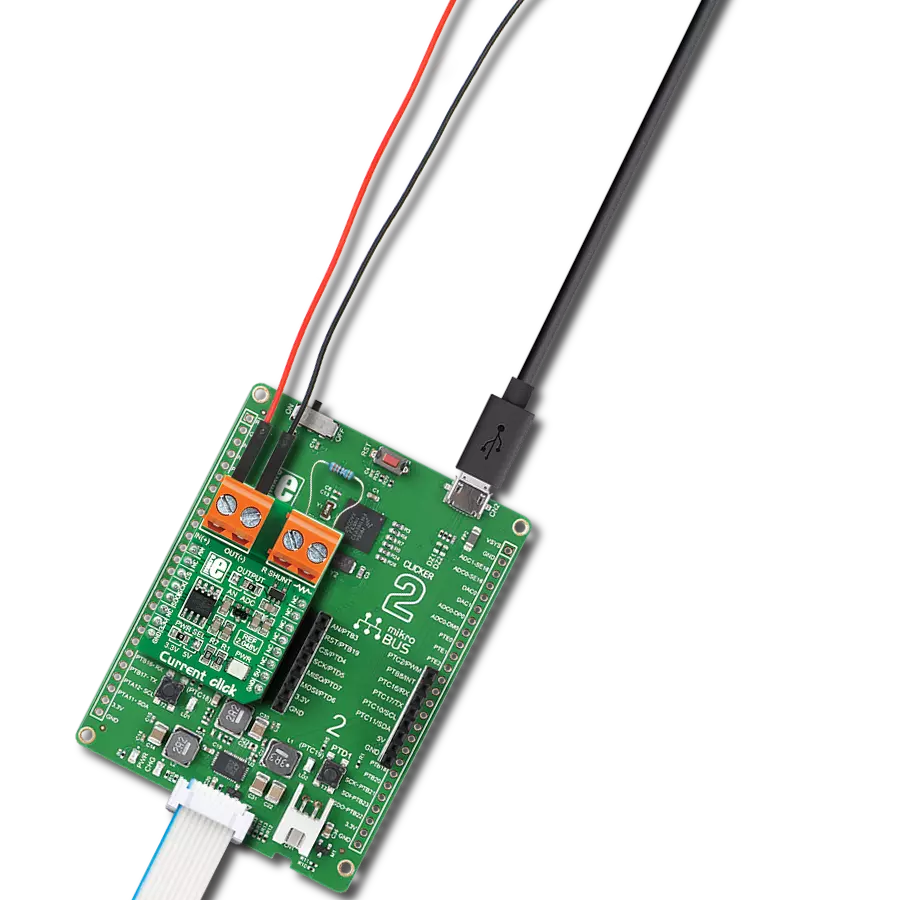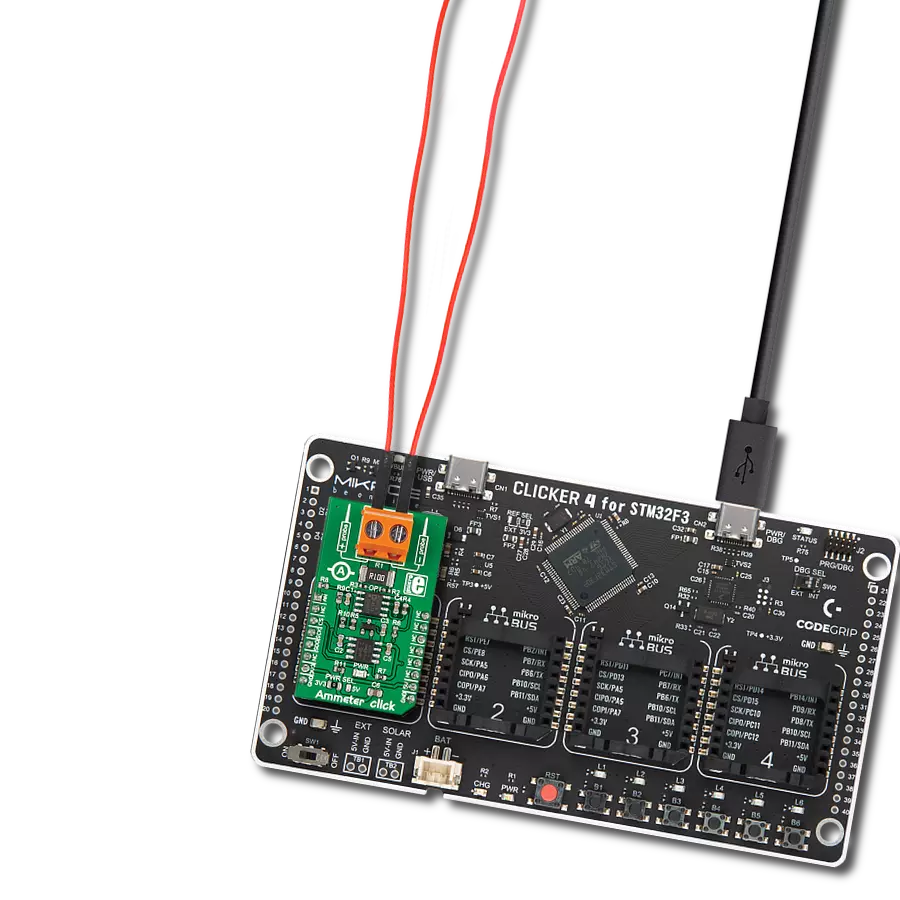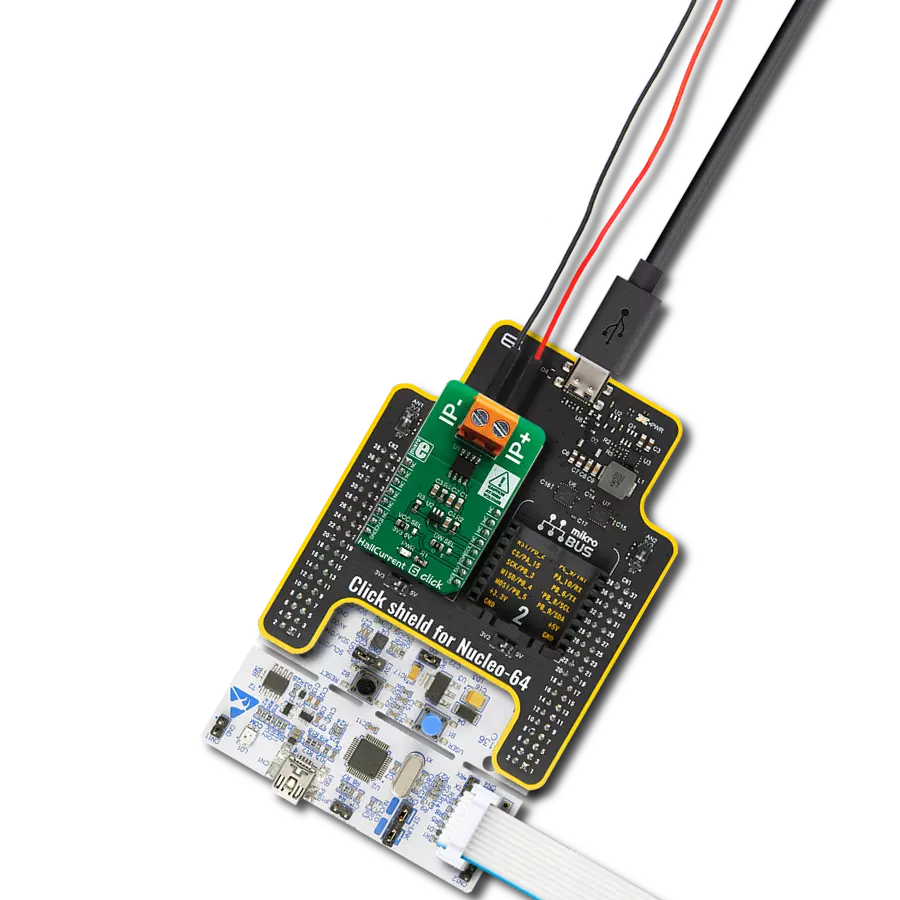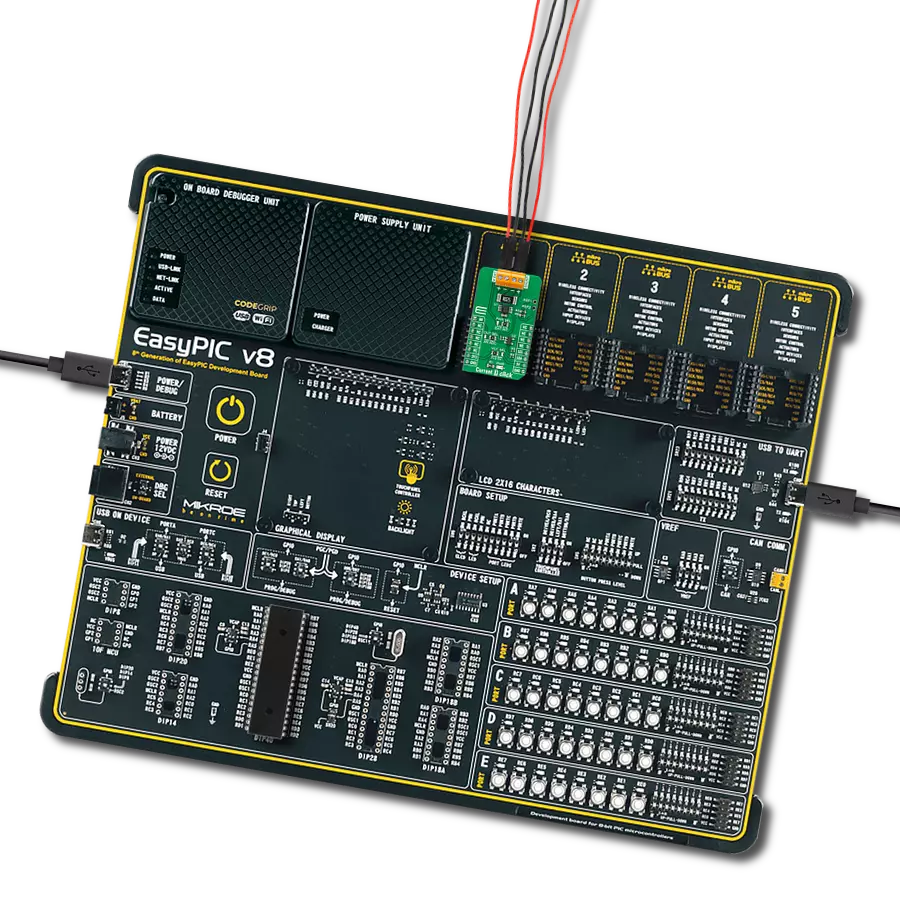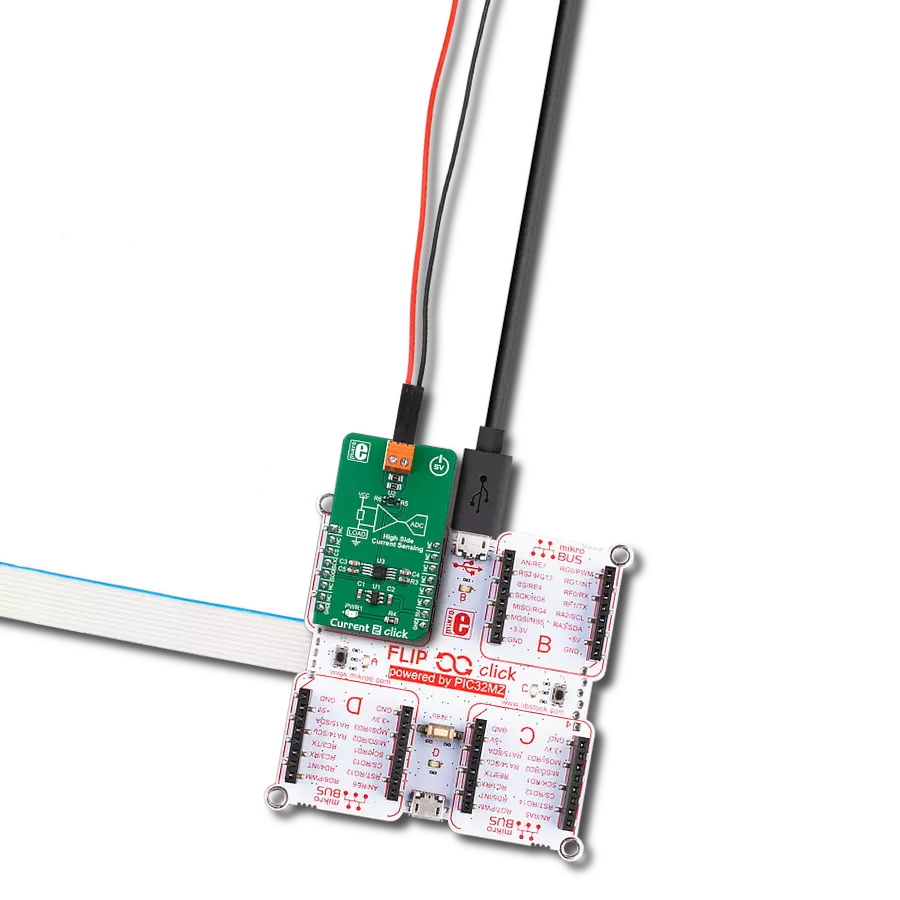Experience enhanced reliability with our Hall-effect current sensing technology, which offers precise measurements even in challenging environments
A
A
Hardware Overview
How does it work?
Hall Current 9 Click is based on the CQ3300, a high-speed response coreless current sensor using a Hall sensor that outputs the analog voltage proportional to the AC/DC from AKM Semiconductor. This current sensor has small-size and high galvanic isolation, specially designed for the current range from -6.4A to +6.4A. Quantum well ultra-thin film of Indium Arsenide is used as the Hall sensor, enabling high-accuracy and high-speed current sensing showing good performance in small-sized inverter applications. It has primary conductor resistance that significantly reduces the heat generated by current compared to a shunt resistor, allowing a continuous current flow of 20Arms. It has an ultra-fast high response of 0.5μs, making it suitable for overcurrent applications. The internal structure of the CQ3300 consists of several blocks such as a primary conductor, Hall sensor, amplifier, buffer, compensation block, bias, and
EEPROM unit. The primary conductor measures the applied current, while the Hall element detects magnetic flux density generated from the measured current. Hall element’s output is then amplified, with a compensation circuit that adjusts the temperature drifts of sensitivity and zero-current output voltage. The last block is the output buffer with gain that outputs the voltage proportional to the current applied to the primary conductor. The CQ3300 has a ratiometric output, which changes proportionally to the supply voltage. It is suitable for applications where the analog output is converted to digital using an A/D converter and where the power supply voltage fluctuation causes reference error of the A/D converter. Just like that, the output voltage can be converted to a digital value using MCP3221, a successive approximation A/D converter with a 12-bit resolution from Microchip, using a 2-wire I2C compatible interface, or can be
sent directly to an analog pin of the mikroBUS™ socket labeled as AN. Selection can be performed by onboard SMD jumper labeled as A/D SEL to an appropriate position marked as AN and ADC. The MCP3221 provides one single-ended input with low power consumption, a low maximum conversion current, and a Standby current of 250 μA and 1 μA, respectively. Data can be transferred at 100kbit/s in the Standard and 400kbit/s in the Fast Mode. Also, maximum sample rates of 22.3 kSPS with the MCP3221 are possible in a Continuous-Conversion Mode with a clock rate of 400 kHz. This Click board™ can be operated only with a 5V logic voltage level. The board must perform appropriate logic voltage level conversion before using MCUs with different logic levels. Also, it comes equipped with a library containing functions and an example code that can be used, as a reference, for further development.

Features overview
Development board
Nucleo-64 with STM32F091RC MCU offers a cost-effective and adaptable platform for developers to explore new ideas and prototype their designs. This board harnesses the versatility of the STM32 microcontroller, enabling users to select the optimal balance of performance and power consumption for their projects. It accommodates the STM32 microcontroller in the LQFP64 package and includes essential components such as a user LED, which doubles as an ARDUINO® signal, alongside user and reset push-buttons, and a 32.768kHz crystal oscillator for precise timing operations. Designed with expansion and flexibility in mind, the Nucleo-64 board features an ARDUINO® Uno V3 expansion connector and ST morpho extension pin
headers, granting complete access to the STM32's I/Os for comprehensive project integration. Power supply options are adaptable, supporting ST-LINK USB VBUS or external power sources, ensuring adaptability in various development environments. The board also has an on-board ST-LINK debugger/programmer with USB re-enumeration capability, simplifying the programming and debugging process. Moreover, the board is designed to simplify advanced development with its external SMPS for efficient Vcore logic supply, support for USB Device full speed or USB SNK/UFP full speed, and built-in cryptographic features, enhancing both the power efficiency and security of projects. Additional connectivity is
provided through dedicated connectors for external SMPS experimentation, a USB connector for the ST-LINK, and a MIPI® debug connector, expanding the possibilities for hardware interfacing and experimentation. Developers will find extensive support through comprehensive free software libraries and examples, courtesy of the STM32Cube MCU Package. This, combined with compatibility with a wide array of Integrated Development Environments (IDEs), including IAR Embedded Workbench®, MDK-ARM, and STM32CubeIDE, ensures a smooth and efficient development experience, allowing users to fully leverage the capabilities of the Nucleo-64 board in their projects.
Microcontroller Overview
MCU Card / MCU
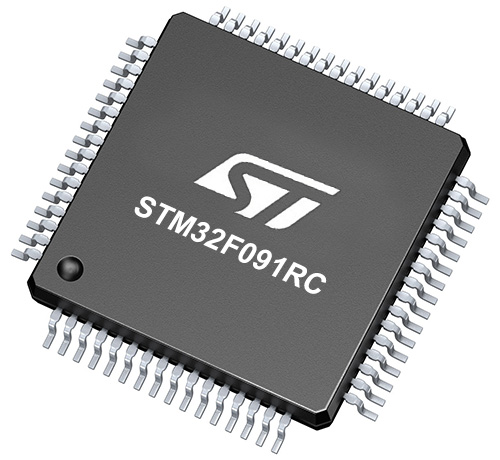
Architecture
ARM Cortex-M0
MCU Memory (KB)
256
Silicon Vendor
STMicroelectronics
Pin count
64
RAM (Bytes)
32768
You complete me!
Accessories
Click Shield for Nucleo-64 comes equipped with two proprietary mikroBUS™ sockets, allowing all the Click board™ devices to be interfaced with the STM32 Nucleo-64 board with no effort. This way, Mikroe allows its users to add any functionality from our ever-growing range of Click boards™, such as WiFi, GSM, GPS, Bluetooth, ZigBee, environmental sensors, LEDs, speech recognition, motor control, movement sensors, and many more. More than 1537 Click boards™, which can be stacked and integrated, are at your disposal. The STM32 Nucleo-64 boards are based on the microcontrollers in 64-pin packages, a 32-bit MCU with an ARM Cortex M4 processor operating at 84MHz, 512Kb Flash, and 96KB SRAM, divided into two regions where the top section represents the ST-Link/V2 debugger and programmer while the bottom section of the board is an actual development board. These boards are controlled and powered conveniently through a USB connection to program and efficiently debug the Nucleo-64 board out of the box, with an additional USB cable connected to the USB mini port on the board. Most of the STM32 microcontroller pins are brought to the IO pins on the left and right edge of the board, which are then connected to two existing mikroBUS™ sockets. This Click Shield also has several switches that perform functions such as selecting the logic levels of analog signals on mikroBUS™ sockets and selecting logic voltage levels of the mikroBUS™ sockets themselves. Besides, the user is offered the possibility of using any Click board™ with the help of existing bidirectional level-shifting voltage translators, regardless of whether the Click board™ operates at a 3.3V or 5V logic voltage level. Once you connect the STM32 Nucleo-64 board with our Click Shield for Nucleo-64, you can access hundreds of Click boards™, working with 3.3V or 5V logic voltage levels.
Used MCU Pins
mikroBUS™ mapper
Take a closer look
Click board™ Schematic

Step by step
Project assembly
Software Support
Library Description
This library contains API for Hall Current 9 Click driver.
Key functions:
hallcurrent9_read_adc- Hall Current 9 I2C ADC reading functionhallcurrent9_set_calibration- Hall Current 9 set calibration functionhallcurrent9_get_current- Hall Current 9 get current function
Open Source
Code example
The complete application code and a ready-to-use project are available through the NECTO Studio Package Manager for direct installation in the NECTO Studio. The application code can also be found on the MIKROE GitHub account.
/*!
* @file main.c
* @brief HallCurrent9 Click example
*
* # Description
* This library contains API for Hall Current 9 Click driver.
* The library contains drivers for measuring ADC values
* and for calculation current.
*
* The demo application is composed of two sections :
*
* ## Application Init
* Initializes I2C driver and triggers the built-in calibration.
*
* ## Application Task
* This is an example that demonstrates the use of the Hall Current 9 Click board.
* In this example, we read and display the ADC and current ( mA ) data.
* Results are being sent to the Usart Terminal where you can track their changes.
*
* @author Nenad Filipovic
*
*/
#include "board.h"
#include "log.h"
#include "hallcurrent9.h"
static hallcurrent9_t hallcurrent9;
static log_t logger;
static uint16_t adc_data;
static float current;
hallcurrent9_calibration_data_t avg_adc_data;
void application_init ( void ) {
log_cfg_t log_cfg; /**< Logger config object. */
hallcurrent9_cfg_t hallcurrent9_cfg; /**< Click config object. */
/**
* Logger initialization.
* Default baud rate: 115200
* Default log level: LOG_LEVEL_DEBUG
* @note If USB_UART_RX and USB_UART_TX
* are defined as HAL_PIN_NC, you will
* need to define them manually for log to work.
* See @b LOG_MAP_USB_UART macro definition for detailed explanation.
*/
LOG_MAP_USB_UART( log_cfg );
log_init( &logger, &log_cfg );
log_printf( &logger, "\r\n" );
log_printf( &logger, "--------------------------\r\n" );
log_printf( &logger, " Hall Current 9 Click \r\n" );
log_printf( &logger, "--------------------------\r\n" );
log_info( &logger, " Application Init " );
// Click initialization.
hallcurrent9_cfg_setup( &hallcurrent9_cfg );
HALLCURRENT9_MAP_MIKROBUS( hallcurrent9_cfg, MIKROBUS_1 );
err_t init_flag = hallcurrent9_init( &hallcurrent9, &hallcurrent9_cfg );
if ( init_flag == I2C_MASTER_ERROR ) {
log_error( &logger, " Application Init Error. " );
log_info( &logger, " Please, run program again... " );
for ( ; ; );
}
log_printf( &logger, "---------------------------\r\n" );
log_printf( &logger, " Calibration \r\n" );
log_printf( &logger, "- - - - - - - - - - - - - -\r\n" );
log_printf( &logger, "> Turn OFF the Power unit <\r\n" );
log_printf( &logger, "- - - - - - - - - - - - - -\r\n" );
log_printf( &logger, " In the following 5 sec. \r\n" );
log_printf( &logger, " turn OFF the Power Supply \r\n" );
Delay_ms ( 1000 );
Delay_ms ( 1000 );
Delay_ms ( 1000 );
Delay_ms ( 1000 );
Delay_ms ( 1000 );
log_printf( &logger, "-------------------------\r\n" );
log_printf( &logger, " Start calibration \r\n" );
if ( hallcurrent9_set_calibration( &hallcurrent9, &avg_adc_data ) == HALLCURRENT9_OK ) {
log_printf( &logger, "---------------------------\r\n" );
log_printf( &logger, " Calibration Done \r\n" );
Delay_ms ( 1000 );
}
log_printf( &logger, "---------------------------\r\n" );
log_printf( &logger, " Start measurements : \r\n" );
log_printf( &logger, "---------------------------\r\n" );
}
void application_task ( void ) {
log_printf( &logger, "--------------------------\r\n", adc_data );
hallcurrent9_read_adc( &hallcurrent9, &adc_data );
log_printf( &logger, " ADC : %d \r\n", adc_data );
current = hallcurrent9_get_current( &hallcurrent9, &avg_adc_data );
log_printf( &logger, " Current : %.2f mA \r\n", current );
Delay_ms ( 1000 );
Delay_ms ( 1000 );
}
int main ( void )
{
/* Do not remove this line or clock might not be set correctly. */
#ifdef PREINIT_SUPPORTED
preinit();
#endif
application_init( );
for ( ; ; )
{
application_task( );
}
return 0;
}
// ------------------------------------------------------------------------ END
Additional Support
Resources
Category:Current sensor



















